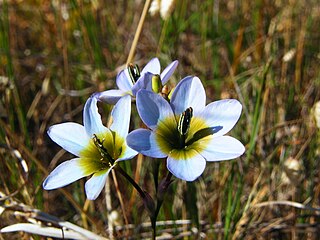
Freesia is a genus of herbaceous perennial flowering plants in the family Iridaceae, first described as a genus in 1866 by Christian Friedrich Ecklon (1886) and named after the German botanist and medical practitioner, Friedrich Freese (1795-1876). It is native to the eastern side of southern Africa, from Kenya south to South Africa, most species being found in Cape Provinces. Species of the former genus Anomatheca are now included in Freesia. The plants commonly known as "freesias", with fragrant funnel-shaped flowers, are cultivated hybrids of a number of Freesia species. Some other species are also grown as ornamental plants.

Moraea aristata is a species of flowering plant in the family Iridaceae. It is referred to by the common names blue-eyed uintjie or Blouooguintjie in Afrikaans.It is endemic to the city of Cape Town and is considered to be critically endangered.

Ixia monadelpha, also known as the pied kalossie or bontkalossie, is an endangered species of geophyte found in wet sandy flats in the southwestern Cape of South Africa.

Acrodon is a genus of ice plants from South Africa. It comprises five species, mostly endangered and all restricted to the southern Cape regions of the Western Cape and Eastern Cape Provinces, South Africa.

Zyrphelis decumbens is a perrenial species of plant from the Bainskloof Mountains in South Africa.

Cyphia bulbosa, also known by its common name Bulb Baroe, is a species of flowering plant from the genus Cyphia.

Acrodon bellidiflorus, the common tiptoothfig, is a mesemb species from South Africa.
Acrodon subulatus, the Overberg tiptoothfig, is a species of mesemb from South Africa.
Acrosanthes anceps is a species of plant from South Africa.
Cheiridopsis schlechteri is a species of plant from South Africa. It is a succulent plant that grows in dry habitats.
Cheiridopsis turbinata is a succulent plant from South Africa.
Cheiridopsis umbrosa is a succulent plant from South Africa.
Cheiridopsis purpurea is a species of succulent plant from South Africa. It is found growing in the succulent Karoo vegetation type.
Cheiridopsis umdausensis is a species of succulent plant from South Africa.
Cheiridopsis velox is a species of succulent plant from South Africa.
Cheiridopsis pilosula is a species of succulent plant from Namaqualand in the Northern Cape of South Africa.
Cheiridopsis ponderosa is a species of succulent plant from South Africa.

Helichrysum retortum, the flask everlasting or sea strawflower, is a species of plant from South Africa.
Senecio sophioides is a species of plant from South Africa.

Lachenalia unifolia, the banded viooltjie, is the most common Lachenalia species in the Cape Floristic Region of South Africa.








